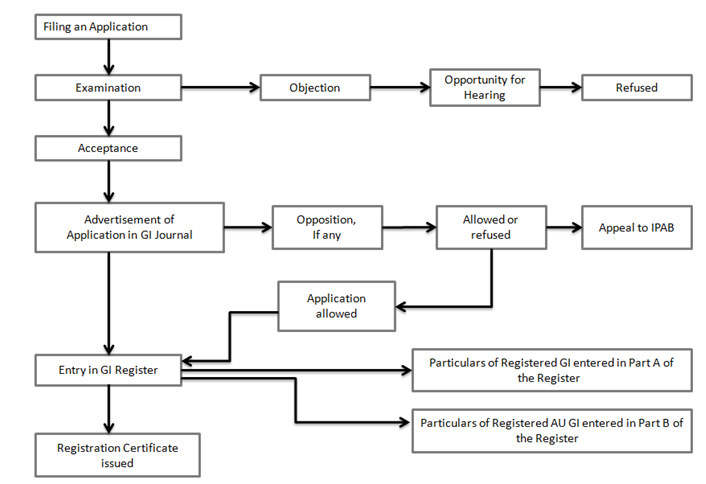Geographical Indication or GI Tags is an intellectual property right given over a product that originates from a specific geographical location and holds qualities that are intrinsic or reputable due to that location. A few examples of GIs are Roquefort Cheese which is a unique form of blue cheese that is aged in Roquefort-Sur-Soulzon, France; Mysore Silk Saree, which is made in the KSIC factory, Mysuru.
GI as an Intellectual Property Right is included in Article 22 of the TRIPS Agreement.[1] It requires the member states to protect the identity of the product, originating from a particular geographical location, and from preventing the use of such identity for any other product not originating from that location, so has to protect the public from getting misled.[2]India, being a signatory of the TRIPS Agreement, subsequently passed the Geographical Indication of Goods (Registration and Protection) Act, 1999[3] and the Rules on Geographical Indication of Goods (Registration and Protection), 2002[4].
Geographical Indication of Goods (Registration and Protection) Act, 1999 (the “Act”):
Meaning of GI under the Indian Law:
Under the Indian law, GIs have been defined as “an indication which identifies such goods as agricultural goods, natural goods or manufactured goods as originating, or manufactured in the territory of a country, or a region or locality in that territory, where a given quality, reputation or other characteristics of such goods is essentially attributable to its geographical origin and in the case where such goods are manufactured goods one of the activities of either the production or of processing or preparation of the goods concerned takes place in such territory, region or locality, as the case may be.”[5]
How to Register GIs:[6]
Step 1: Before filing the Application for GI Tag, one must ensure that their product falls under the ambit of the Act under section 2(e). Once that is confirmed, the Application for GI Tag can be filed under section 11 of the Act. Three copies of the Application need to be made containing:
- statement of the case for GI Tag
- class of good to which GI is applicable
- three certified copies of the geographical map of the region to which the GI belongs
- description of the GI
- details of the applicants with their addresses
The Application should be sent to the following address in India:
Geographical Indications Registry
Intellectual Property Office Building Industrial Estate,
G.S.T Road Guindy, Chennai – 600 032, Phone: 044 – 22502091-93 & 98
Fax: 044 – 22502090
E-mail:gir-ipo@nic.in
Website: ipindia.gov.in
Step 2: Scrutiny of the Application will be done by the Registrar to find out any insufficiency, which would have to be corrected within one month of having received the communication for the same. Thereafter, the statement of the case will be reviewed by the experts and consequently, an Examination Report will be issued.
Step 3: If there is any objection concerning the Application by the Registrar, it will be communicated, and the Application would have to reply or apply for a hearing for the same within two months of receiving such communication. The Applicant would then have two months to file for an appeal for such a decision if he/she so wishes.
Step 4: Within 3 months of acceptance of the Application, it has to be published in the Geographical Indications Journal.
Step 5: A notice of opposition can be filed by anyone opposing the GI Application within three months. A copy of the Notice will be sent to the Applicant and the Applicant is required to send a counter-statement within 2 months. Thereafter, evidence will be presented by both parties along with supporting documents, and the date for hearing the matter will be fixed.
If no counter statement is sent by the Applicant, it will be deemed that the Applicant has abandoned his/her application.
Step 6: Once the hearing is over and the Application is accepted, the GI will be registered by the Registrar. Thereafter, the certificate of registration will be issued to the Applicant with the seal of the GI Registry. The date of filing of the Application shall be considered the date of registration.
Step 7: GI is appliable for a period of 10 years and is required to be renewed by payment of a renewable fee.
[Image Source: ipindia.gov.in]
Concluding Remarks:
With the ambit of Intellectual Property Rights ever-growing, the need for its protection is growing as well. India has been prominent in understanding the value of such rights and has successfully signed and ratified the TRIPS Agreement. The execution of the GIs in India has been rising ever since, with the Darjeeling Tea becoming the first GI registered under the Act. The Indian government has sought to simplify the process of registration so as to protect the culture and the rights of people. This process encompasses filing of a detailed Application, its Examination, Acceptance (if no objections are made), Advertisement of the Application in the GI Journal, Entry in the GI Register (if no objections are made), and finally issuance of the GI Registration Certificate which would be valid for 10 years.
Author: Sanjhi Sharma, an intern at Khurana & Khurana, Advocates and IP Attorneys. In case of any queries please contact/write back to us at aishani@khuranaandkhurana.com.
References:
[1]TRIPS: Agreement on Trade-Related Aspects of Intellectual Property Rights, Apr. 15, 1994, Part II, s. 3, Art. 22 (1994) [hereinafter TRIPS Agreement].
[2]Id.
[3]Geographical Indications of Goods (Registration and Protection) Act, 1999,No. 48, Acts of Parliament, 1999 (India).
[4]The Geographical Indications of Goods (Registration and Protection) Rules, 2002 (India).
[5]Supra note 3, s. 2(e).
[6]Office of the Controller General of Patents, Designs & Trade Marks, Department for Promotion of Industry and Internal Trade, Ministry of Commerce & Industry, Government of India, The Registration Process, https://ipindia.gov.in/the-registration-process-gi.htm.




